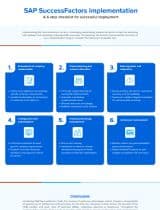Mastering SAP SuccessFactors implementation: A six-step checklist for a smooth launch
Have you ever implemented new software in your company? If so, you're aware that this task always presents a significant challenge, especially when dealing with a comprehensive Human Capital Management (HCM) solution like SAP SuccessFactors.
Zalaris

Maintaining efficiency and effectiveness is not automatic. To ensure a successful SAP SuccessFactors implementation in your organisation, requires careful planning and foresight.
Before we delve into the tips, it's important to note that the implementation of SAP SuccessFactors can vary slightly from one organisation to another due to differing requirements for an HCM solution and the existing technology landscape. Nevertheless, there are some universal principles that you should consider in any case if you want to ensure a smooth and successful SAP SuccessFactors implementation. Here are six tips that will help you achieve just that.
SAP SuccessFactors implementation: Six tips for a successful launch
1. Assessment of company requirements
2. Project planning and resource allocation
3. Data migration and integration
4. Configuration and customisation
5. Training and change management
6. Continuous improvement
Tip 1: Assessing company requirements
First and foremost, you should be clear about what you want to achieve-or must achieve-with the SAP SuccessFactors implementation. The central questions to answer are:
- What deficiencies do we see in our current Human Capital Management (HCM) or Human Experience Management (HXM), and what potential exists?
- How can the implementation of SAP SuccessFactors help optimise these processes?
- What are the long-term goals we want to achieve with the introduction of SAP SuccessFactors?
Without a specific definition of requirements and without setting specific (long-term) goals, software can never be efficiently introduced and ultimately used. You wouldn't know what you need, and you might either inadequately support your processes or possibly pay for modules that are not relevant to your needs. Without goals, it's also challenging to clearly identify successes or failures.
An essential part of assessing your company's requirements is gaining an overview of the capabilities that SAP SuccessFactors offers. Examine the system's functionalities closely and determine which ones best support your company's Human Capital Management and Human Experience Management, always in consideration of existing deficiencies, potentials, and objectives.
Know more on the topic

Tip 2: Project planning and resource allocation
A highly effective SAP SuccessFactors implementation generally requires a significant amount of time and resources. Careful project planning and precise allocation of responsibilities are essential. In this context, you should consider the following to-dos:
Assemble a dedicated implementation team:
Involve individuals from your HR and IT departments in project planning and implementation. Anyone who will ultimately interact with the system should be involved in the SAP SuccessFactors implementation. The required team size and structure depend mainly on the number and complexity of the SAP SuccessFactors modules you plan to implement.
Assign roles appropriately:
Even in small project teams, there should be specific coordinators responsible for organising, documenting, and reporting on all activities to advance the project. Furthermore, you need to allocate the actual tasks to the right employees. At this point, you should assess whether you can implement all relevant modules in-house or if you require external support. Compatibility with your existing system landscape plays a crucial role. If necessary, individual integrations may need to be created by specialised professionals.
Establish milestones and a schedule:
Understand that SAP SuccessFactors implementation is a time-consuming endeavor. The system offers modules that cover all aspects of HR management, such as recruiting and onboarding, payroll, workforce planning, and talent management. The implementation can take between three and ten months, often depending on how much it deviates from the standard. Under these circumstances, you should create your own timeline and coordinate with external resources. Defining milestones is also important to structure the process efficiently.
Tip 3: Data migration and integration
Business software can typically achieve its full effectiveness only when it has a robust data foundation for its processes.
First, the existing HR data should be checked for cleanliness, correctness, and compatibility or optimised if necessary.
Secondly, the information generated during the SAP SuccessFactors implementation should be immediately formatted correctly.
Once clean information structures are in place, it's time to test the migration. Move smaller datasets into a testing environment to see how well the information from your legacy system integrates into the new SAP SuccessFactors implementation.
This phase is perfect for identifying whether data is lost during the process or unexpected incompatibilities arise. If you successfully complete the test, you can proceed with the final migration.
Tip 4: Configuration and customisation
You can customise SAP SuccessFactors to align with your company's requirements. This especially applies to organisational structure, hierarchy, typical workflows, and approval-related processes.
Create a list of all modules and integrations that need to be implemented to meet all requirements. If you aim for a more limited SAP SuccessFactors integration, you must pay even closer attention to ensuring it aligns with the rest of your HR system landscape or making it compatible. If you plan to handle all your HCM and HXM processes through SAP SuccessFactors, more in-house processes will need to be adjusted to fit your established workflows.
The SAP SuccessFactors Integration Center allows for straightforward integrations. Modules and integrations can be customised and tested.
Tip 5: Training and change management
Even if the SAP SuccessFactors implementation runs perfectly from an organisational and technical standpoint, significant problems can arise on another level: employees often resist change as established tools and processes are not easily abandoned.
Therefore, it is crucial to establish a meaningful, well-developed change management strategy. The value and benefits of implementing SAP SuccessFactors can only be fully realised if your employees genuinely use the tools. Transparent and continuous communication is vital here. If you don't inform future users well and educate them about the benefits of using the system and how it works, the new software is likely to be rejected.
In this context, it is also essential to provide adequate training for all involved employees. Because, of course, the participants can only fully utilise the application if they are well-versed in using SAP SuccessFactors. Otherwise, much potential will remain untapped. Additionally, early communication about the introduction of SAP SuccessFactors is another crucial factor for acceptance among the workforce.
Tip 6: Continuous improvement
SAP SuccessFactors not only requires a wealth of well-structured data to function optimally but also provides information to help you continuously optimise your HR processes. By using specific analysis functions, you can gain valuable insights into your HR work.
However, this is only possible if you have defined concrete goals that you can now assess based on the information you've gathered. It's usually a good idea to estimate the scope of SAP SuccessFactors implementation and its usage as precisely as possible. Based on these assumptions, you can then define goals and ultimately express what success looks like. Objectives such as "The onboarding process should be fully automated" give everyone a clear idea of how things should work after the SAP SuccessFactors implementation.
Of course, many other success factors or requirements are conceivable and often relevant. User acceptance forms an important foundation for overall effectiveness:
- Are all employees using SAP SuccessFactors without problems?
- Has the introduction of SAP SuccessFactors increased efficiency?
- Have we saved time that was previously spent on repetitive tasks?
- Have we successfully avoided downtime or data loss?
All these and other factors can be important in defining success or setting goals and ultimately reviewing and optimising them. Make sure you don't lose sight of your company's requirements and deficiencies in your original HCM or HXM processes.
Final thoughts
Introducing SAP SuccessFactors holds the promise of numerous advantages, and its inherent customisability empowers you to optimise your HR processes for the long haul. However, to fully harness the benefits of this HCM solution and steer clear of potential pitfalls, meticulous planning is paramount. Throughout the implementation journey, factors such as seamless data migration, precise configuration, and comprehensive training for your team are pivotal to ensuring success.
Download checklist
Enter your details below to get instant access to exclusive resources.
